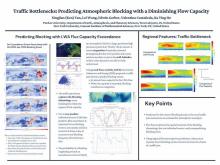Predicting Atmospheric Blocking with the Traffic Jam Mechanism: The Role of Merging
Xingjian
Yan
New York University
Poster
Atmospheric blocking is an enigmatic stagnation phenomena of propagating Rossby wave packets in midlatitudes. A traffic jam theory proposed by Nakamura and Huang predicted that blocking events occur when Local Wave Activity (LWA) flux exceeds a capacity. However, the predictability of atmospheric blocking with the traffic jam theory remains to be examined in atmospheric reanalysis. By calculating both theory-approximated and direct-regression flux capacities, we find that the theory captures the spatial structure of the blocking climatology, but not individual events, tending to overpredict blocking onset. An unproportionally large number of capacity-exceeding wave events fail to evolve into blocking events. We thus propose to use regional features to improve predictors. Summarized as a “traffic merging” analogy, a decrease in capacity favors blocking, as lane closures increase the chance of a traffic jam. Combining the zonal span of flux and the zonal decrease in capacity, the “traffic merging” analogy effectively reduces false positive predictions. A 1D idealized model with longitudinal-varying stochastic forcing is adopted to further assess the role of traffic merging to a changing climate.

Poster file
Yan-Xingjian-blocking-poster.pdf
(433.22 KB)
Meeting homepage
